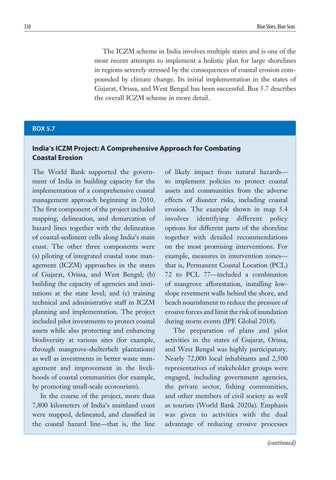330
Blue Skies, Blue Seas
The ICZM scheme in India involves multiple states and is one of the most recent attempts to implement a holistic plan for large shorelines in regions severely stressed by the consequences of coastal erosion compounded by climate change. Its initial implementation in the states of Gujarat, Orissa, and West Bengal has been successful. Box 5.7 describes the overall ICZM scheme in more detail.
BOX 5.7
India’s ICZM Project: A Comprehensive Approach for Combating Coastal Erosion The World Bank supported the government of India in building capacity for the implementation of a comprehensive coastal management approach beginning in 2010. The first component of the project included mapping, delineation, and demarcation of hazard lines together with the delineation of coastal-sediment cells along India’s main coast. The other three components were (a) piloting of integrated coastal zone management (ICZM) approaches in the states of Gujarat, Orissa, and West Bengal; (b) building the capacity of agencies and institutions at the state level; and (c) training technical and administrative staff in ICZM planning and implementation. The project included pilot investments to protect coastal assets while also protecting and enhancing bio diversity at various sites (for example, through mangrove-shelterbelt plantations) as well as investments in better waste management and improvement in the livelihoods of coastal communities (for example, by promoting small-scale ecotourism). In the course of the project, more than 7,800 kilometers of India’s mainland coast were mapped, delineated, and classified in the coastal hazard line—that is, the line
of likely impact from natural hazards— to implement policies to protect coastal assets and communities from the adverse effects of disaster risks, including coastal erosion. The example shown in map 5.4 involves identifying different policy options for different parts of the shoreline together with detailed recommendations on the most promising interventions. For example, measures in intervention zones— that is, Permanent Coastal Location (PCL) 72 to PCL 77—included a combination of mangrove afforestation, installing lowslope revetment walls behind the shore, and beach nourishment to reduce the pressure of erosive forces and limit the risk of inundation during storm events (IPE Global 2018). The preparation of plans and pilot activities in the states of Gujarat, Orissa, and West Bengal was highly participatory. Nearly 72,000 local inhabitants and 2,500 representatives of stakeholder groups were engaged, including government agencies, the private sector, fishing communities, and other members of civil society as well as tourists (World Bank 2020a). Emphasis was given to activities with the dual advantage of reducing erosive processes (continued)






